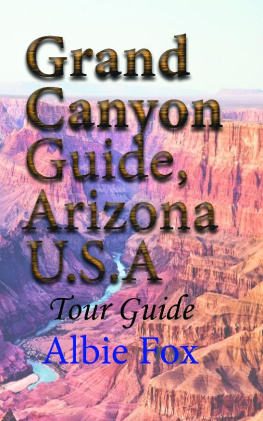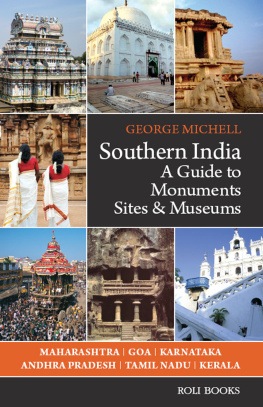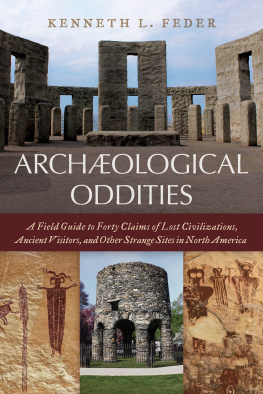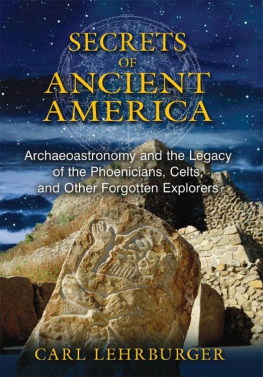Acknowledgments
I guess the Grateful Dead had it right when they sang: Lately it occurs to me, what a long strange trip its been. Thats been true for me both literally and figuratively. Long and strange, to be sure. But more important, its also been exciting and glorious. And now theres a book. I couldnt be happier.
As you are probably aware, books always are collaborative efforts. A large group of people contribute, though their names dont end up on the front cover. But without the help of all of those folks, this book would never have come to life.
First, many colleagues helped by actually bringing me to some of the sites enshrined on my list of fifty. Brad Lepper of the Ohio Historical Society was instrumental as my archaeological tour guide to the sites in Ohio. Brad is the best colleague anyone could hope for; on this and many other projects, he has been an amazing source of information, assistance, and inspiration. Brad also hooked me up with Andy Sawyer at SunWatch Indian Village, and the folks there simply could not have been nicer; Sun-Watch is a great place to learn about Americas past. Also in Ohio, thanks to Katie Rippl for guiding me through Fort Ancient and to Keith Bengston at Serpent Mound. I also must thank Rick Perkins, my personal guide at Mound City. Bill Iseminger at Cahokia is a brilliant archaeologist, as well as a talented writer and artist. He has always been extremely generous to me, and this project has been no exception.
Dont hate me, but I was able to avoid the red tape usually required to visit Little Petroglyph Canyon in California. I have Naval Air Weapons Station base archaeologist Mike Baskerville to thank for that. I got the personal tour, and I cant thank Mike enough.
Desi and Ken Ekstein were helpful and generous with directions to additional sites and also for Desis spectacular drone photographs of the Blythe Intaglios. Our meeting at Blythe was pure serendipity, and I am so grateful for what they contributed. Thanks also are due to Lyn Hood and Steve Horton, who were incredibly helpful at the Three Rivers Petroglyph Site. They have served as the sites recreation hosts (yup, thats their official title), living at the site in their recreational vehicle. What a cool job! Im jealous.
No list of acknowledgments would be complete without expressing my sincerest thanks to Harris Hardy for his moving and heartfelt discourse on the significance of Canyon de Chelly. For Harris the canyon isnt a site, its home; I cant imagine a better way of learning about the place than having him as my guide. Greg Lameman was our river guide on the San Juan from Bluff to Medicine Hat. He went out of his way to bring us to the rock art. And thanks to Greg, I didnt fall out of the raft and drown at 8-Foot Rapids. I genuinely appreciate that!
Though the Volcanic Table Lands sites that BLM archaeologist Greg Haverstock introduced me to in Southern California are not among my fifty, they certainly form the nucleus of fifty more sites you can see for yourself. He went above and beyond, taking the better part of a day to drive us around. Of course he should thank me for giving him an excuse to get out of the office on a beautiful June day. Youre welcome, Greg! Greg also introduced me to rock art researcher David Lee, and I am grateful to him for our extremely interesting conversation about the meaning of the art and the importance of its protection and preservation. David gave me a lot to think about. Tom Sanders at the Jefferson Petroglyph Site in Minnesota devoted several hours of his time to guide me through that rock art site, even though it was seasonally closed when I was there. It was fascinating to visit a site so different from those I had encountered in the Southwest.
Susan Pease is the Dean of Arts and Sciences at my institution, Central Connecticut University. She has been remarkably supportive of all my various projects over the years, including the work that led to this book. My deepest thanks, Susan; your help has been greatly appreciated. (Okay, now that Ive given you a shout-out, can I have some more funding for travel? Pretty please.)
As you read this book, youll figure out that my fifty sites project was a quintessential labor of love. And how wonderful to get to share that labor with the people at Rowman & Littlefield. You could not wipe the smile off my face after my initial telephone conversation with R&L editor Leanne Silverman. After discussing my project for more than an hour and a half, Leanne said, Well, Kenny, youve probably figured out that I have been talking to you for this long because Im really interested in publishing this book. Shes been a joy to work with. But shes not alone in deserving thanks here; Leanne has minions! A million thanks (thats 20,000 for each of my fifty sites) to assistant editor Carli Hansen, who managed to keep the many parts of the juggling act that was this project in the air at the same time; Karie Simpson, who was tremendously helpful with issues related to the figures; Jehanne Schweitzer, senior production editor extraordinaire, who was incredibly helpful in the copyediting and keeping me on task, not always an easy thing to do; and Andrea Kendrick, the assistant editor at the beginning of the project. I genuinely appreciate a copy edit in which my voice can still be heard and people who know my work can say, Thats Kennys writing alright. And his grammar certainly is improving. A great big thanks to Paulette Baker for accomplishing that monumental task.
I think my kids, Josh and Jacob, figured out in a hurry that all those family vacations werent really vacations at all but research trips. At least thats what I told them to say if they were ever called on to testify before the IRS. Wait; should I be saying this in print? Whatever! In truth, I cant imagine anything better than involving my kids in my archaeological odyssey. You should too (I mean you should involve your kids, not mine). I thank them for their patience, unique insights, and active participation.
And then theres Jenn, who joined me midway through my archaeological odysseyand midway through my life. Jenn has an almost supernatural ability to find petroglyph and pictograph panels. I guess I should be particularly pleased that she is enamored of ancient things, as I increasingly fit into that category. Love you, Jenny-bean.
A lot of people deserve my deep and fundamental appreciation for making this book possible. Those are the folks who had the foresight to recognize that archaeological sites are important, interesting, valuable, significant, and worthy of protection and preservation. I include in that list Teddy Roosevelt; the National Park Service; the Bureau of Land Management; state, county, and town site stewards; as well private families who have made it their duty to preserve the past for the future. Without their efforts, the fifty sites honored in this book might not exist.
Finallyand I know this will sound lame in a world where irony often trumps sincerityI must give credit where credit is due: Americas first peoples. It was, after all, their labor, imagination, creativity, artistry, and genius that created the places I take you to in this book. And it is to those people I give my ultimate thank you.
Enough! Now its your turn. Go hike, climb, explore, study, learn, and revel in Americas remarkable past. I hope you enjoy your odysseys through time as much as I have enjoyed mine.
Ancient America
H eres a very, very brief summary of North American prehistory, providing some general anthropological and historical context for the sites well be visiting in this book. Think of this as the equivalent of Shakespeare in 5 Minutes.
Who Are the American Indians?
To begin, all American Indians are related biologically, culturally, and historically, but they are not all identical peoples bearing exactly the same culture. Its like Europe: The people who live there are all Europeans, but they are also French, Italian, Spanish, British, Swedish, German, Polish, and so forth. There is plenty of cultural diversity among the native peoples of Europedifferent languages, religions, foods, art, traditions, architecturejust as there is plenty of cultural diversity among the native peoples of North America.





